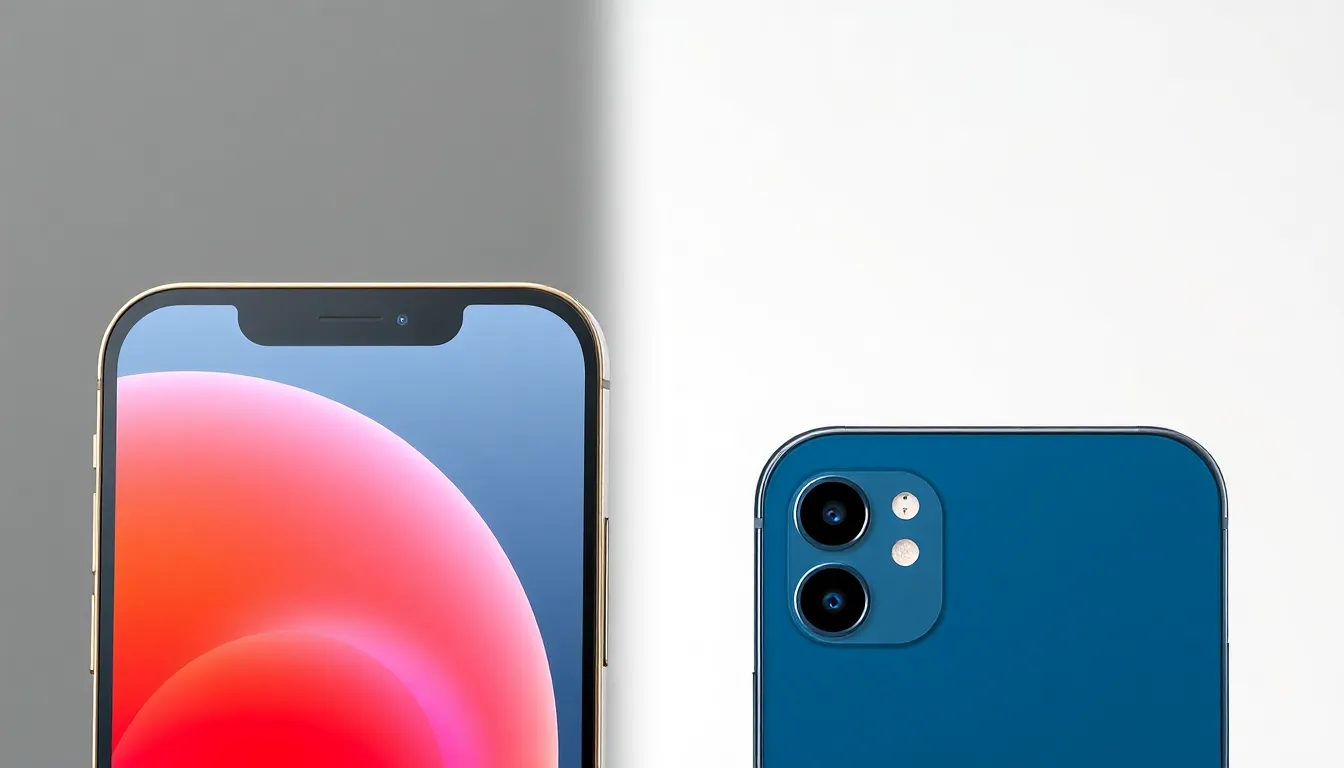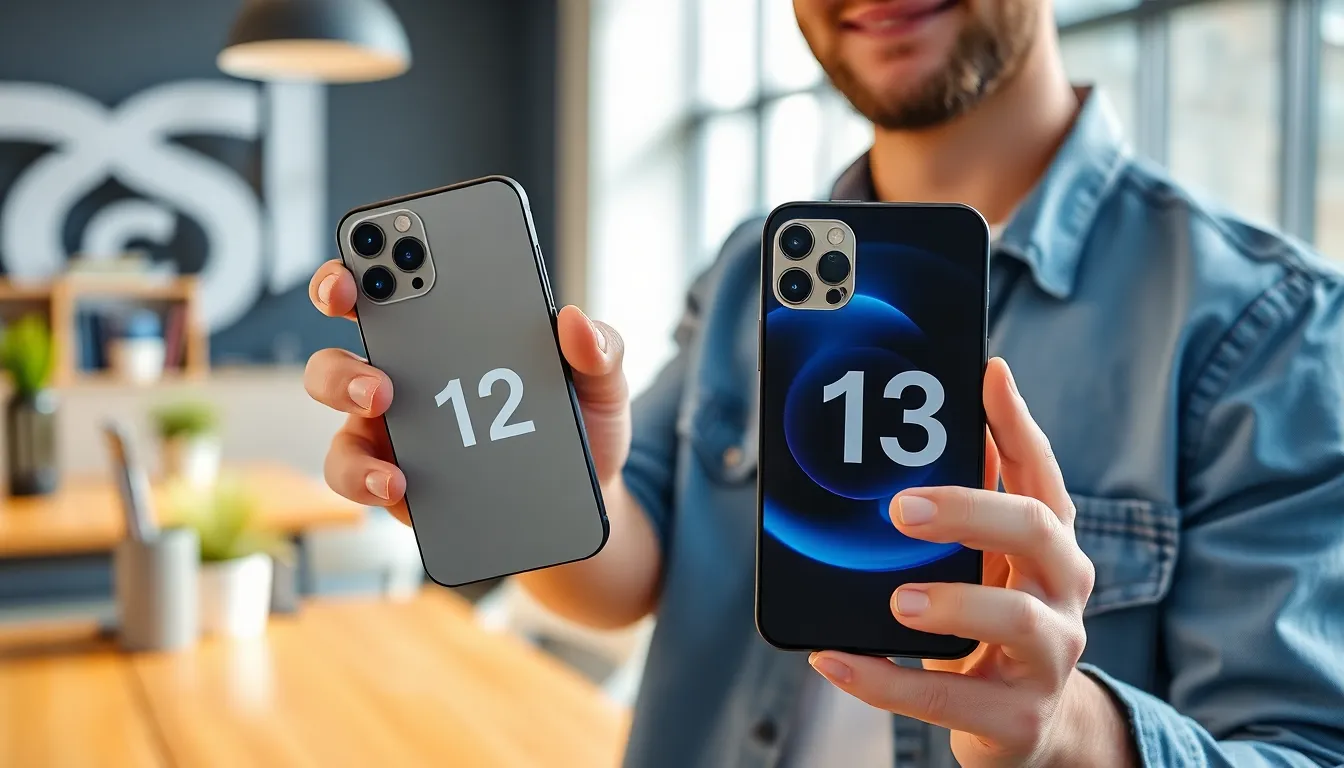In the epic showdown of smartphones, the iPhone 12 and iPhone 13 are like two heavyweight contenders in a tech ring. Both pack a punch with sleek designs and impressive features, but which one truly deserves the crown? Picture this: you’re in the market for a new phone, and you stumble upon these two beauties. One’s got a shiny new chip and camera upgrades, while the other has already proven its worth in the wild.
Table of Contents
ToggleOverview of iPhone 12 and iPhone 13
iPhone 12 and iPhone 13 showcase impressive designs and cutting-edge technology. Both models feature a flat-edge aluminum and glass architecture, which offers a premium feel. Display size remains consistent at 6.1 inches for both, presenting vivid colors and sharp resolution through Supers Retina XDR screens.
Camera capabilities significantly evolve with the iPhone 13. It includes a dual-camera system with larger sensors for improved night photography and enhanced low-light performance. Photographic Styles and Cinematic mode introduce innovative features for capturing video. Comparatively, the iPhone 12’s cameras provide excellent performance but lack some of the advanced options featured in its successor.
Processing speed also distinguishes both models. The iPhone 13 utilizes A15 Bionic chip, boosting performance in graphics-intensive tasks and extending battery life. Conversely, the iPhone 12 operates on the A14 Bionic chip, which is still powerful but less efficient than its newer counterpart.
Battery life presents another point of differentiation. Users can expect around 17 hours of video playback on the iPhone 12, whereas the iPhone 13 offers up to 19 hours due to improved energy efficiency.
Storage options vary as well. The iPhone 12 starts with a base storage of 64GB, while the iPhone 13 begins at 128GB, catering to users with greater storage needs.
Both iPhones deliver strong performance, appealing designs, and impressive capabilities. Choosing between them depends on whether users prioritize advanced camera features and processing power or leverage the established performance of the iPhone 12.
Design Comparisons

The design of the iPhone 12 and iPhone 13 showcases modern aesthetics and functionality. Both devices maintain a flat-edge aluminum and glass architecture, creating a premium look and feel.
Dimensions and Weight
The iPhone 12 measures 146.7 x 71.5 x 7.4 mm and weighs 164 grams. In contrast, the iPhone 13 slightly increases in size at 146.7 x 71.5 x 7.65 mm, while its weight is 173 grams. This subtle difference reflects how Apple optimized internal components in the iPhone 13, resulting in a slightly heavier device without sacrificing ergonomics. Both phones fit comfortably in hand, making them user-friendly for extended use.
Color Options
Color choices enhance the visual appeal of both models. The iPhone 12 offers black, white, red, green, and blue options, giving users a solid range of colors to express their style. Alternatively, the iPhone 13 introduces new color options, including pink, blue, midnight, starlight, and product red, expanding the personalization possibilities. Limited editions, like the Product Red, reflect Apple’s commitment to social causes, making color choice more than just a personal preference. Users benefit from distinct visuals while enjoying the design integrity of both phones.
Display Quality
Display quality plays a crucial role in user experience for both the iPhone 12 and iPhone 13. Each device features a 6.1-inch Super Retina XDR screen, providing sharp visuals and vibrant colors.
Screen Size and Resolution
Both models offer a resolution of 2532 x 1170 pixels. This specification ensures sharpness in text and detail in images. The iPhone 12 and 13 maintain the same pixel density of 460 ppi, equally delivering crisp and clear content. Users enjoy watching videos and playing games with little to no distortion. Each model’s size fits comfortably in hand, making it easy to navigate.
Brightness and Color Accuracy
Brightness capabilities set these devices apart. The iPhone 12 features a maximum brightness of 625 nits, while the iPhone 13 pushes that to 800 nits for regular usage. Under HDR conditions, the iPhone 13 reaches an impressive peak brightness of 1200 nits, enhancing the viewing experience in varying light conditions. Furthermore, both phones support HDR10, ensuring they reproduce colors accurately across the spectrum. Users benefit from excellent color depth and saturation, enhancing overall enjoyment.
Performance Analysis
Performance stands as a pivotal factor when comparing the iPhone 12 and iPhone 13, particularly in terms of processing capabilities and battery stamina.
Processor and RAM
The iPhone 13 features the A15 Bionic chip, offering enhanced speed and efficiency compared to the A14 Bionic chip in the iPhone 12. Faster processing times significantly improve app performance and multitasking capabilities. In addition to increased speed, the A15 Bionic supports advanced features like smarter machine learning and graphics handling. RAM configurations remain steady, with both models featuring 4GB, yet the A15’s architecture optimizes performance in demanding applications. Users frequently benefit from improved responsiveness and smoother operation across tasks.
Battery Life
Battery life represents another vital differentiator between these devices. The iPhone 12 allows approximately 17 hours of video playback, while the iPhone 13 extends this to around 19 hours. Enhanced efficiency from the A15 chip contributes to superior battery management. Regular users appreciate the additional hours of usage, particularly during long days without charging. Quick charging capabilities and support for MagSafe accessories enhance convenience for both models. Overall, the extended battery life in the iPhone 13 makes it a more suitable choice for those seeking longevity during heavy use.
Camera Capabilities
Camera capabilities distinguish the iPhone 12 and iPhone 13. Each offers unique features that cater to different photography needs.
Main Camera Features
The iPhone 13 features a dual-camera system that enhances photography versatility. Larger sensors improve low-light performance, resulting in sharper night shots. Photographic Styles add customization options for making photos pop, catering to individual preferences. Cinematic mode introduces a new level of creativity with dramatic focus shifts during video recording. In contrast, the iPhone 12 excels with its dual-camera design, capturing vibrant images but lacking the advanced options of its successor. Both models focus on optical image stabilization to minimize blurriness, ensuring clear results in varied conditions. Users benefit from enhanced computational photography in the iPhone 13, enhancing overall imaging quality.
Front Camera Features
Both iPhones sport a 12MP front camera designed for high-quality selfies and video calls. Enhanced night mode on the iPhone 13 delivers better performance in low-light environments, making it easier to capture clear images while out at night. The iPhone 13 also supports Photographic Styles for the front camera, allowing for a personalized touch in selfies. Additionally, the iPhone 13 retains features like QuickTake and 4K video recording at 60 fps, ensuring smooth video playback. The iPhone 12 supports 4K video, but it lacks the enhanced features offered by the iPhone 13. Users of both models will appreciate the quality of video calls, thanks to reliable front camera capabilities.
Pricing and Availability
Pricing for the iPhone 12 varies; it typically starts around $599 for the base 64GB model. On the other hand, the iPhone 13’s starting price is about $799 for the 128GB version. That $200 difference reflects enhancements in processing power and camera capabilities.
Availability also plays a crucial role in the decision-making process. The iPhone 12 remains widely available through retailers and carriers, as it is part of Apple’s ongoing lineup. Contrastingly, many retailers may sell out of the iPhone 13 quickly, especially during promotional seasons due to its high demand.
Carrier options exist for both models, with major providers offering various plans to spread the cost over time. Discounts may apply for those switching carriers or signing up for new accounts, helping users save on upfront expenses.
Direct purchases from Apple also provide different options for trade-ins, which might reduce costs further. Apple’s website typically showcases availability and offers discounts based on trade-in values, enhancing affordability.
Sales events can significantly impact pricing. During Black Friday or back-to-school sales, both models may see marked-down prices or bundle deals. Checking major retailers as well as the Apple Store could reveal competitive offers that make either phone more accessible.
Ultimately, when deciding, cost and availability heavily influence the buying process. Users seeking the latest features may opt for the iPhone 13, while those looking for value without sacrificing quality may find the iPhone 12 appealing.
Choosing between the iPhone 12 and iPhone 13 ultimately hinges on individual preferences and needs. Those who value cutting-edge features and enhanced performance may find the iPhone 13 to be the better option. Its improved camera capabilities and longer battery life cater to users who prioritize photography and extended usage.
On the other hand, the iPhone 12 remains a solid choice for those seeking a reliable device at a lower price point. It offers excellent performance and a stunning display without the latest enhancements. Ultimately, both models deliver a premium experience, making either a worthy investment depending on what users prioritize in their smartphone experience.




